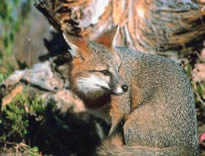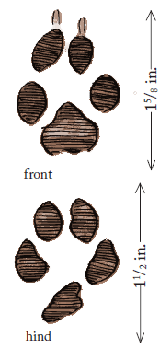Wildlife - Species

Species Specific Regulations
Gray Fox
Licenses: Hunting License required.
Limits: Weapon restrictions according to game zones please check for Limitations.

Gray fox tracks
Gray Fox (Urocyon cineroargenteus)
Description
Slightly smaller than the red fox. Basically gray in color, it has reddish or rusty areas under the throat, on the sides of the neck and on the legs. The amount of red varies, often causing this fox to be mistaken for a red fox. Gray foxes can be identified by the black-tipped tail while the red fox is identified by a white tail tip.
Average Size
The gray fox stands about 15 inches at the shoulder and weighs 7 to 10 lbs.
Life Expectancy
The oldest recorded gray fox in South Carolina was 9 years old.
Preferred Habitat
The gray fox is considered a woodland inhabitant. While it benefits from an interspersion of forests and fields, it can also be found in fully timbered areas. In mixed areas of openland and woods, gray foxes' ranges may overlap those of red
foxes. Unlike the red fox, the gray is able to climb trees and does so occasionally to escape predators and hunting dogs. The gray fox's ability to climb and its adaptation to completely forested areas may explain why they have not been displaced by coyotes, as red foxes have in some areas.
Range
Gray foxes are found in all 48 contiguous states, except Montana and Idaho. They are abundant throughout most of South Carolina.
Food Habits
The primary food of the gray fox is small mammals such as rats, mice and rabbits. They have been known to occasionally feed on poultry, small birds and insects. Plant foods are more important to the gray fox than the red fox. Grays commonly eat persimmons, grapes and acorns. They will also eat carrion.
Reproduction
Peak Breeding Activity
Gray foxes are monogamous, breeding in winter, usually late February and March.
The young start leaving the den for short periods of time at 5 weeks of age and may associate with the parents until the next breeding season.
Gestation
53 days and the average litter size is 3 to 5.
Miscellaneous
Gray fox populations experience periodic outbreaks of canine distemper, and parasites may be a problem. The annual mortality rate is estimated at 52%.
Foxes were once considered vermin, and bounties were paid for them in some counties. Today, fox fur is fashionable, and many sport trappers recognize their value commercially. Foxes also play a beneficial role in controlling cotton rats, which are major predators on the nests of quail and other ground-nesting birds. Gray foxes, taken primarily by trapping, are second only to the raccoon in numbers commercially harvested. Statewide, gray foxes outnumber red foxes about 4 to 1. Though gray foxes are plentiful in South Carolina, sport hunting by houndsmen is dwindling because of increased development, the growing chain of highways, which threaten the hounds, and the increase in populations of “off-game” species such as deer, which distract the hounds.
Publications and Literature
Baker, O.E., Carmichael, D. Breck, South Carolina Furbearers. Wildlife and Freshwater Fisheries Division. Columbia, South Carolina
Fur Harvest Hunting and Trapping are provided in the Fur Harvest Brochure which is a summary of the state statutes regarding the commercial harvest of furbearers. Applicable statutes are listed in parentheses at the end of each section of this brochure. Copies of actual statutes of the SC Code of Laws are available online from the SC Legislature at www.scstatehouse.gov or by writing: Furbearer Program, SC Department of Natural Resources, P.O. Box 167, Columbia, SC 29202.
Some of the files above are provided in the Adobe® Acrobat® (PDF) format. Adobe® Reader® is required to open these files and is available as a free download from the Adobe® Web site.
Jay Butfiloski - Furbearer Project Supervisor
SCDNR Furbearer Project
P. O. Box 167
Columbia, SC 29202-0167
Phone: 803-734-3886
Fax: 803-734-6020
E-mail: ButfiloskiJ@dnr.sc.gov

